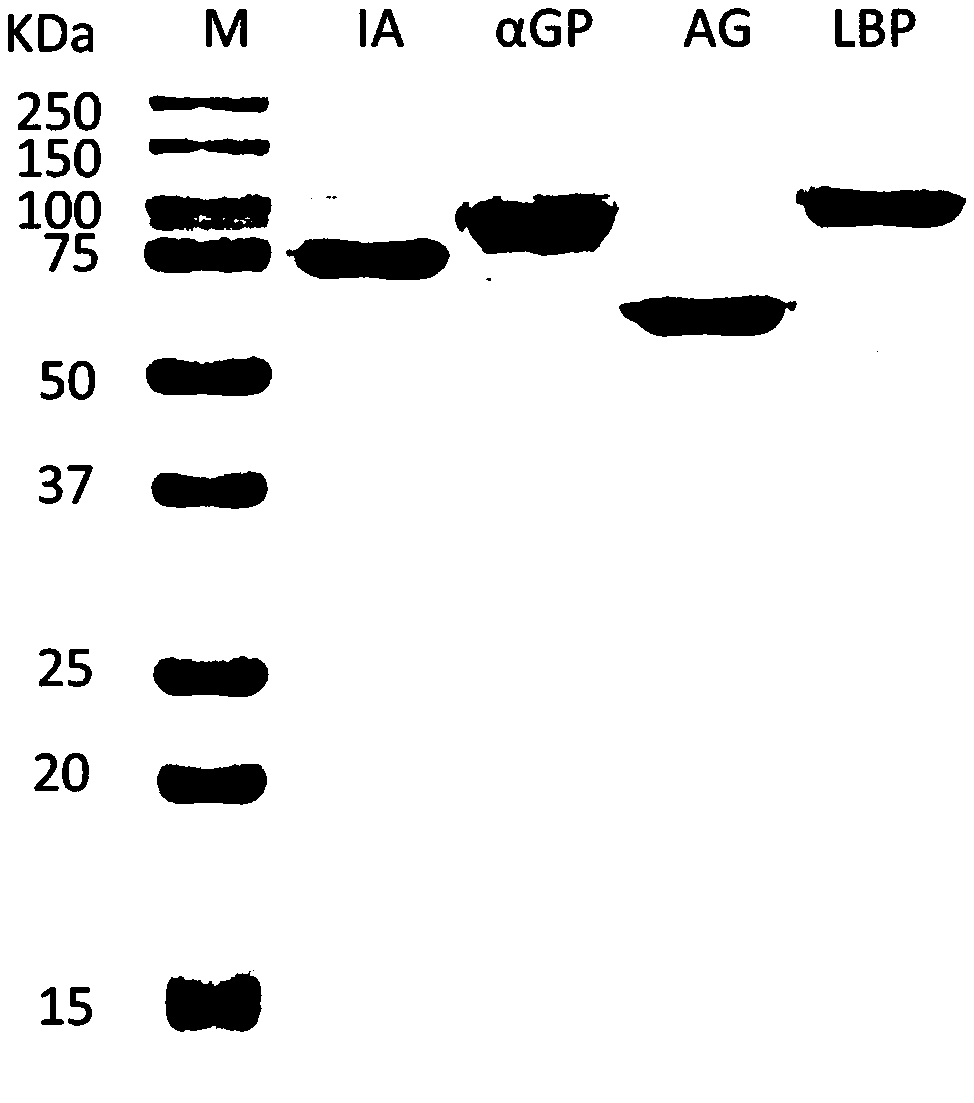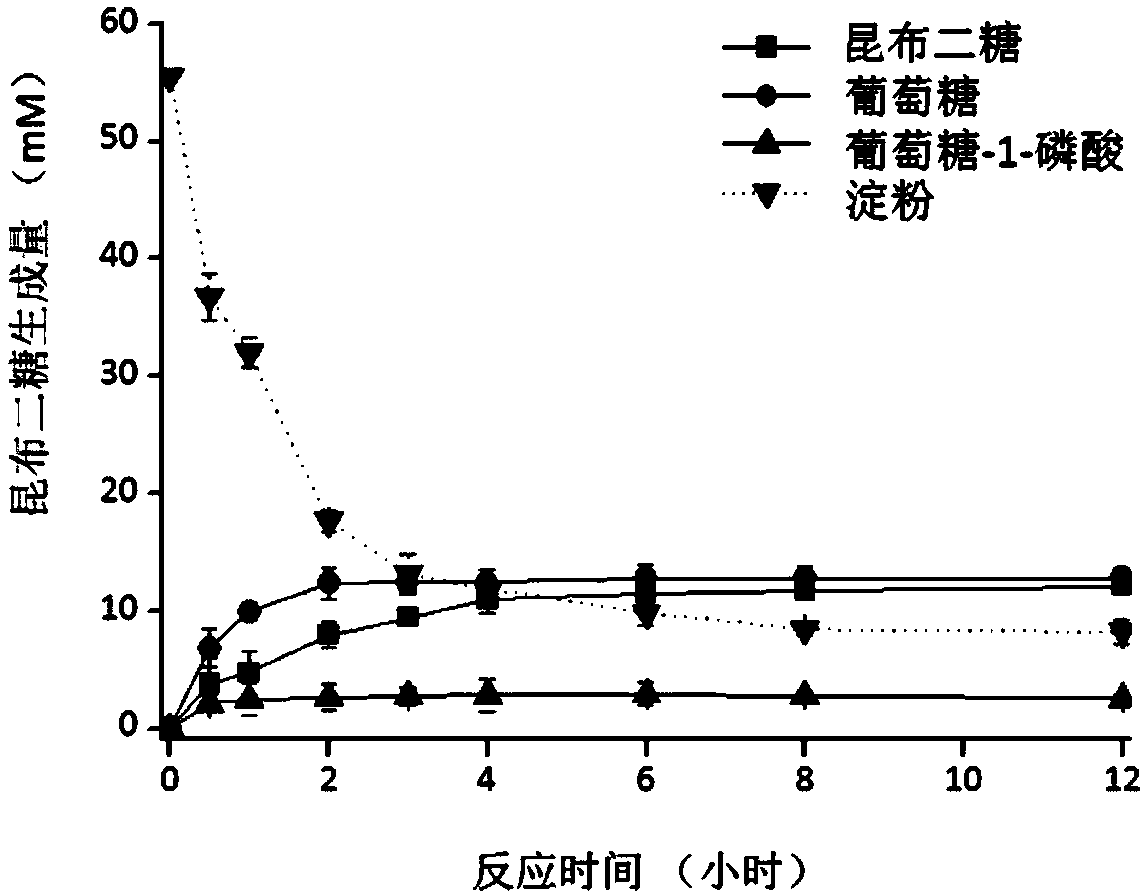Method for preparing laminaribiose through starch conversion
A technology of kelp disaccharide and catalytic preparation, applied in the direction of fermentation, can solve the problem of high cost of separation, and achieve the effects of improved conversion efficiency, high yield and high utilization rate of raw materials
- Summary
- Abstract
- Description
- Claims
- Application Information
AI Technical Summary
Problems solved by technology
Method used
Image
Examples
Embodiment 1
[0047] Example 1 In vitro multi-enzyme catalysis converts starch into laminaribiose
[0048] Catalytic pathway for the conversion of starch to laminaribiose by a multi-enzyme catalytic system in vitro see figure 1 . The key enzymes and key steps involved include: (1) starch phosphorylase (αGP, EC 2.4.1.1), which is used to release glucose-1-phosphate from starch; (2) glucosidase (AG, EC 3.2 .1.20), used to release glucose from starch; (3) laminaribiose phosphorylase (LBP, EC 2.4.1.31), used to catalyze the formation of laminaribiose from glucose-1-phosphate and glucose.
[0049] In this embodiment, the starch phosphorylase is derived from Thermotoga maritima, whose gene number on KEGG is TM1168; the glucosidase is derived from Paecilomyces lilacinus, whose gene is listed on KEGG The number on KEGG is QAQ81244; laminaribiose phosphorylase is derived from Paenibacillus sp., and its gene number on KEGG is BAJ10826. These genomic DNAs are all available from the official website...
Embodiment 2
[0053] Example 2 Improve the yield of laminaribiose by adding enzymes that promote starch hydrolysis
[0054] Starch phosphorylase cannot completely hydrolyze starch, such as figure 1 It was shown that isoamylase can assist in the hydrolysis of starch, that is, adding isoamylase (IA, EC 3.2.1.68) that can help hydrolyze starch in the reaction system can increase the yield of laminaribiose.
[0055] In this example, the isoamylase is derived from Sulfolobus tokodaii, whose gene number on KEGG is ST0928, and the genomic DNA of this strain is purchased from DSMZ, the German Culture Collection. This gene was obtained from the corresponding genomic DNA by PCR with primers F4 / R4, wherein, F3: GTTTAACTTTAAGAAGGAGATATAATGGTTTTTTCACAAGGATAGACC, R: GTGGTGGTGGTGGTGGTGCTCGAGCTAATATTCAATCCCTATATACC, and cloned into the pET20b vector by the method of Simple Cloning to obtain the corresponding expression vector pET20b-StIA. Then, this plasmid was transformed into Escherichia coli expression...
Embodiment 3
[0060] Example 3 By optimizing the reaction system, the yield of laminaribiose is further improved
[0061] The preparation of isoamylase, starch phosphorylase, glucosidase and laminaribiose phosphorylase is the same as in Example 1.
[0062] The reaction system contains 5mM sodium acetate buffer solution (pH 5.5), 0.5mM divalent zinc ions, 5U / mL isoamylase, and 200g / L starch, and the catalytic reaction is carried out at 85°C for 3 hours.
[0063] After gradual optimization, it was determined that the optimum concentration of potassium phosphate was 20mM, the optimum amount of enzymes added was 2U / mL of starch phosphorylase, 1U / mL of glucosidase, and 3U / mL of laminaribiose phosphorylase, and then the reaction system contained 100mM HEPES buffer (pH6.5), 5mM divalent zinc ions, 20mM potassium phosphate (pH 6.5), 2U / mL starch phosphorylase, 1U / mL glucosidase, 3U / mL laminaribiose phosphorylase, 10g / L IA-treated starch was catalyzed at 50°C for 12 hours, and the detection of lami...
PUM
 Login to View More
Login to View More Abstract
Description
Claims
Application Information
 Login to View More
Login to View More - R&D
- Intellectual Property
- Life Sciences
- Materials
- Tech Scout
- Unparalleled Data Quality
- Higher Quality Content
- 60% Fewer Hallucinations
Browse by: Latest US Patents, China's latest patents, Technical Efficacy Thesaurus, Application Domain, Technology Topic, Popular Technical Reports.
© 2025 PatSnap. All rights reserved.Legal|Privacy policy|Modern Slavery Act Transparency Statement|Sitemap|About US| Contact US: help@patsnap.com



